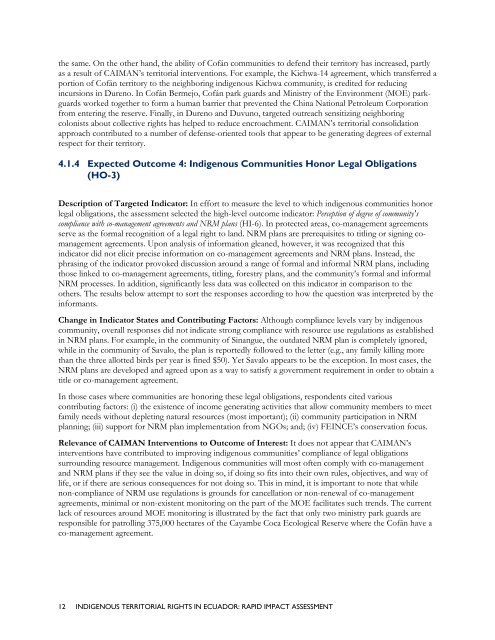ECUADOR - Land Tenure and Property Rights Portal
ECUADOR - Land Tenure and Property Rights Portal
ECUADOR - Land Tenure and Property Rights Portal
- No tags were found...
You also want an ePaper? Increase the reach of your titles
YUMPU automatically turns print PDFs into web optimized ePapers that Google loves.
the same. On the other h<strong>and</strong>, the ability of Cofán communities to defend their territory has increased, partlyas a result of CAIMAN’s territorial interventions. For example, the Kichwa-14 agreement, which transferred aportion of Cofán territory to the neighboring indigenous Kichwa community, is credited for reducingincursions in Dureno. In Cofán Bermejo, Cofán park guards <strong>and</strong> Ministry of the Environment (MOE) parkguardsworked together to form a human barrier that prevented the China National Petroleum Corporationfrom entering the reserve. Finally, in Dureno <strong>and</strong> Duvuno, targeted outreach sensitizing neighboringcolonists about collective rights has helped to reduce encroachment. CAIMAN’s territorial consolidationapproach contributed to a number of defense-oriented tools that appear to be generating degrees of externalrespect for their territory.4.1.4 Expected Outcome 4: Indigenous Communities Honor Legal Obligations(HO-3)Description of Targeted Indicator: In effort to measure the level to which indigenous communities honorlegal obligations, the assessment selected the high-level outcome indicator: Perception of degree of community'scompliance with co-management agreements <strong>and</strong> NRM plans (HI-6). In protected areas, co-management agreementsserve as the formal recognition of a legal right to l<strong>and</strong>. NRM plans are prerequisites to titling or signing comanagementagreements. Upon analysis of information gleaned, however, it was recognized that thisindicator did not elicit precise information on co-management agreements <strong>and</strong> NRM plans. Instead, thephrasing of the indicator provoked discussion around a range of formal <strong>and</strong> informal NRM plans, includingthose linked to co-management agreements, titling, forestry plans, <strong>and</strong> the community’s formal <strong>and</strong> informalNRM processes. In addition, significantly less data was collected on this indicator in comparison to theothers. The results below attempt to sort the responses according to how the question was interpreted by theinformants.Change in Indicator States <strong>and</strong> Contributing Factors: Although compliance levels vary by indigenouscommunity, overall responses did not indicate strong compliance with resource use regulations as establishedin NRM plans. For example, in the community of Sinangue, the outdated NRM plan is completely ignored,while in the community of Savalo, the plan is reportedly followed to the letter (e.g., any family killing morethan the three allotted birds per year is fined $50). Yet Savalo appears to be the exception. In most cases, theNRM plans are developed <strong>and</strong> agreed upon as a way to satisfy a government requirement in order to obtain atitle or co-management agreement.In those cases where communities are honoring these legal obligations, respondents cited variouscontributing factors: (i) the existence of income generating activities that allow community members to meetfamily needs without depleting natural resources (most important); (ii) community participation in NRMplanning; (iii) support for NRM plan implementation from NGOs; <strong>and</strong>; (iv) FEINCE’s conservation focus.Relevance of CAIMAN Interventions to Outcome of Interest: It does not appear that CAIMAN’sinterventions have contributed to improving indigenous communities’ compliance of legal obligationssurrounding resource management. Indigenous communities will most often comply with co-management<strong>and</strong> NRM plans if they see the value in doing so, if doing so fits into their own rules, objectives, <strong>and</strong> way oflife, or if there are serious consequences for not doing so. This in mind, it is important to note that whilenon-compliance of NRM use regulations is grounds for cancellation or non-renewal of co-managementagreements, minimal or non-existent monitoring on the part of the MOE facilitates such trends. The currentlack of resources around MOE monitoring is illustrated by the fact that only two ministry park guards areresponsible for patrolling 375,000 hectares of the Cayambe Coca Ecological Reserve where the Cofán have aco-management agreement.12 INDIGENOUS TERRITORIAL RIGHTS IN <strong>ECUADOR</strong>: RAPID IMPACT ASSESSMENT
















